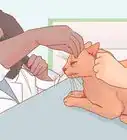This article was co-authored by Tabitha Kucera. Tabitha Kucera is a Registered Veterinary Technician & Cat and Dog Behavior Consultant and the Owner of Chirrups and Chatter Cat and Dog Behavior Consulting and Training in Cleveland, Ohio. Tabitha has over ten years of experience working at animal veterinary hospitals, farm sanctuaries, and cat and dog rescue centers. Tabitha has helped to develop training and behavior programs for various veterinary hospitals and shelters and works as a consultant for many shelters and private veterinary practices. Her teaching credentials include lecturing at regional and national levels and at multiple veterinary technology programs. She is a Fear Free certified speaker, a Fear Free Practice Certification Consultant, a behavior consultant for Cat Pawsitive Pro, and host of the podcast, Tails from a Vet Tech. She currently serves on the board of the Pet Professional Guild’s Cat Committee and is the President of the Society of Veterinary Behavior Technicians. She is an Elite Fear Free and Low-Stress Handling Certified Registered Veterinary Technician, a certified cat behavior consultant, a Karen Pryor Academy certified training partner, and has a Veterinary Technician Specialist (VTS) designation in behavior.
This article has been viewed 24,601 times.
Thunderstorms can make cats anxious. A thunderstorm’s noise, along with other storm-related events like lightning, can make a cat run for cover until the storm passes. If your cat gets anxious when a storm comes, it will be important for you to calm it down. The better you can manage your cat’s anxiety, the calmer your cat will be during thunderstorms.
Steps
Creating a Safe Environment During the Storm
-
1Give your cat a safe space to hide during the storm. Providing a safe hiding place is probably one of the best treatment strategies for thunderstorm anxiety in cats. Ideal hiding places are dark and quiet, such as a basement, closet, or bathroom. Put your cat’s ‘creature comforts’ (e.g., food and water bowls, favorite toys, blanket) in the area to make it more comfortable.[1]
- If your cat already has a usual hiding spot, such as under a bed, put its creature comforts in that area.
- If the hiding space has windows, close the curtains or blinds to block the sight of the storm.
- Do not disturb your cat when it goes to its hiding place. Let your cat come out when it’s ready.
-
2Turn on ‘white noise’ during the storm. If thunderstorm noises make your cat anxious, turn on some background noise, such as the television or radio, that will serve as a distraction from the storm.[2] If you turn on the radio, pick a station playing soothing music (smooth jazz or classical) or a talk radio station. A television news station could help your cat tune out the thunderstorm noise.
- Do not crank up the volume of the white noise. Doing so could increase your cat's stress and anxiety.
- Play the white noise before the storm comes so your cat can get comfortable with it.
- Classical music or white noise sounds are usually the best option, since it's not possible to control what's coming out of the TV or the radio, and these sounds might stress your cat even more.
Advertisement -
3Play with your cat. On the day of a storm, schedule some additional play time with your cat. The extra exercise will make your cat physically and mentally tired, which will help it remain more calm when the storm comes.[3]
- Have your cat chase a laser light across the floor and play jumping games.
-
4Comfort your cat in the way that they prefer. You cannot reinforce emotional states and should always comfort your cat in a way that they enjoy. Provide a safe place, minimize the stressful stimuli of the storm, close the curtains and windows, and comfort your cat in the way that they prefer.
-
5Provide your cat with items they enjoy during the storm. This could be a delicious treat on a LickiMat, a play session, or turning on their favorite interactive toy.
-
6Keep yourself calm during the storm. Your cat will be able to sense your emotions before and during the storm. If you’re anxious, your cat will be too. Do activities, such as quietly reading or watching TV, that show calmness during the storm.[4]
Using Medication to Treat Thunderstorm Anxiety
-
1Discuss medication options with your vet. Anxiety-reducing drugs, called anxiolytics, are commonly used to treat thunderstorm anxiety in cats. Long-acting anxiolytics, such as Clomicalm® (clomipramine) and Reconcile® (fluoxetine), should be given throughout storm season. Quick-acting anxiolytics, including Valium® (diazepam) and Xanax® (alprazolam), are useful when given for an individual storm event. As your cat’s anxiety reduces, your vet may taper the medication dosage, or completely discontinue the medication.[5]
- Sometimes, different types of drugs can interact with each other and cause side effects.[6] Your vet will check your cat’s current medications, if any, to make sure the anxiolytic will not interact with them.
-
2Administer the medication as prescribed. If your cat needs a quick-acting anxiolytic, your vet will want you to administer it before your cat starts showing behavioral signs of thunderstorm anxiety. For example, if you know in the morning that a thunderstorm is coming later in the day, start administering the medication in the morning. Long-acting anxiolytics are usually given daily.
- Your vet will give you specific administration instructions, depending on which medication(s) your cat needs.
-
3Do not give your cat acepromazine. Acepromazine is a drug used for sedation. Although it has been commonly given to pets to relieve thunderstorm and fireworks anxiety, it doesn’t actually lessen the anxiety. It only lessens the ability for a pet to move or show the outward signs of anxiety. In other words, acepromazine works like a ‘chemical straitjacket’ that prevents the appearance of anxiety.[7]
- If your vet recommends acepromazine for your cat, express your concerns about the use of this drug and ask about other anxiety-reducing medications.
-
4Consider non-medicated alternatives. If you do not want to give your cat medications, consider other therapies. For example, a product called Rescue Remedy is a spray made up of flower essences. It can produce a sense of calm. In addition, you could use the cat pheromone product Feliway® to give your cat something familiar and calming to smell. Melatonin can also help relieve thunderstorm anxiety.
- Pheromones are chemicals secreted by the body. Your cat will rub its cheek on furniture to deposit pheromones to mark its territory. [8]
- Discuss these alternative therapies with your vet before using them.
Recognizing Signs of Thunderstorm Anxiety
-
1Observing hiding behavior. A cat’s first instinct during a thunderstorm is to hide. Your cat may dash under a piece of furniture or try to hide in of your kitchen cabinets. This hiding behavior, known as avoidance, usually works quite well for cats when they are afraid of a thunderstorm. When the storm ends, your cat will emerge from its hiding place.
-
2Take your cat to your vet. Whether your cat’s thunderstorm anxiety is mild or exaggerated, a veterinary examination can help determine the most effective way to treat the anxiety. For example, your cat may have an underlying health condition that's increasing its stress and anxiety.[9] Treating that condition, along with using other anxiety-reducing strategies, could help decrease your cat's thunderstorm anxiety.
- Your vet will physically examine your cat and ask you questions about the thunderstorm anxiety. The more information you provide, the easier it will be for your vet to devise an effective treatment plan.
-
3Work with a behavior professional to help your cat. They can help you train your cat to be less anxious and stressed during thunderstorms.




Thanks for reading our article! If you'd like to learn more about cats' behavior , check out our in-depth interview with Tabitha Kucera.
Thanks for reading our article! If you'd like to learn more about controlling cats' behavior, check out our in-depth interview with Tabitha Kucera.
Warnings
- If your cat has a thunderstorm phobia, it may be aggressive toward you. For example, if you try to pick up your cat when it's frightened, you may get bitten or scratched.⧼thumbs_response⧽
- An untreated phobia can cause chronic stress, which can lead to a weakened immune system and other health problems.[11]⧼thumbs_response⧽
Expert Interview
Expert Interview




Thanks for reading our article! If you'd like to learn more about cats' behavior , check out our in-depth interview with Tabitha Kucera.
Thanks for reading our article! If you'd like to learn more about controlling cats' behavior, check out our in-depth interview with Tabitha Kucera.
References
- ↑ http://www.humanesociety.org/news/magazines/2010/05-06/finding_calm_in_the_storm.html
- ↑ http://www.preventivevet.com/dogs/why-you-shouldnt-use-acepromazine-for-cats-and-dogs
- ↑ https://perimeterveterinarycenter.com/2016/03/01/shawnee-ks-vet-anxiety-cats/
- ↑ http://catscradleshelter.org/2016/07/11/thunderstorm-fear-in-cats/
- ↑ http://www.humanesociety.org/news/magazines/2010/05-06/finding_calm_in_the_storm.html
- ↑ http://www.preventivevet.com/dogs/why-you-shouldnt-use-acepromazine-for-cats-and-dogs
- ↑ http://www.preventivevet.com/dogs/why-you-shouldnt-use-acepromazine-for-cats-and-dogs
- ↑ https://indoorpet.osu.edu/cats/basicneeds/feliway
- ↑ https://perimeterveterinarycenter.com/2016/03/01/shawnee-ks-vet-anxiety-cats/
About This Article
To treat thunderstorm anxiety in your cat, provide a safe space for it to hide in during the storm, like a basement, closet, or bathroom. Put its favorite toys, a blanket, and some food and water in the safe space so it’s comfortable until it decides to come out. Since the noise from a thunderstorm can make your cat anxious, distract it with some background noise by turning on the television or radio. Remember, your cat can sense your emotions, so try to remain calm before and during the storm by watching television or reading a book. For more advice from our Veterinary co-author, including how to recognize signs of thunderstorm anxiety, keep reading!


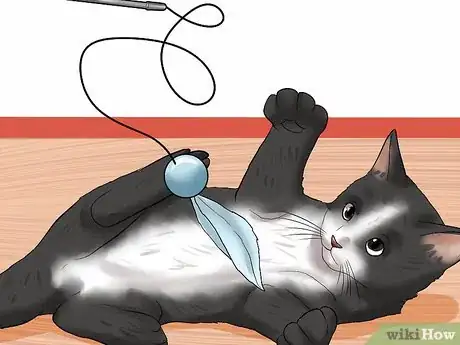
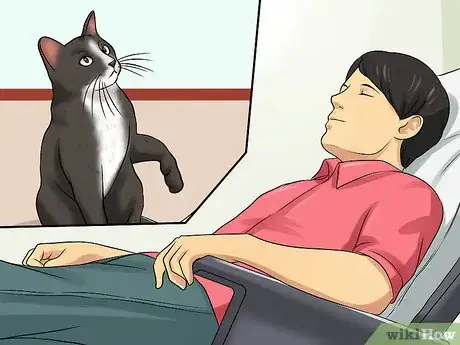

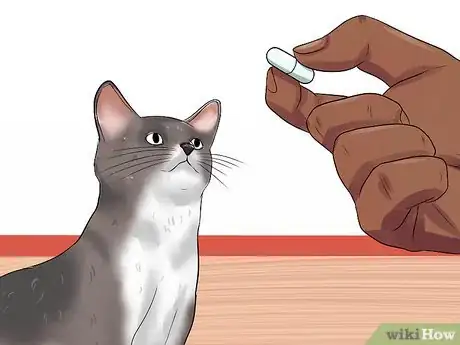

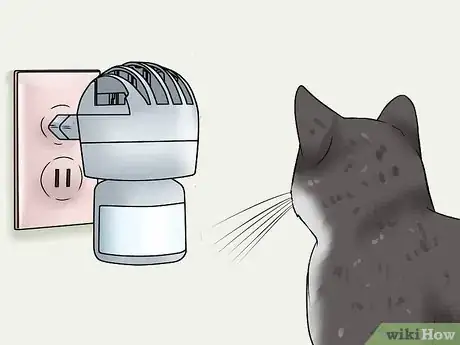
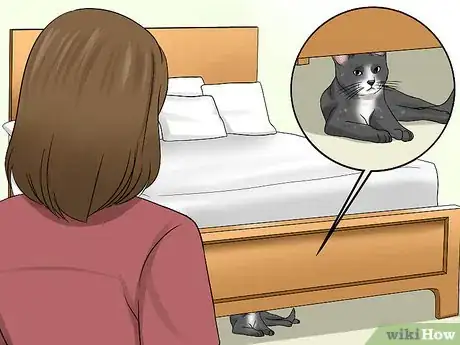
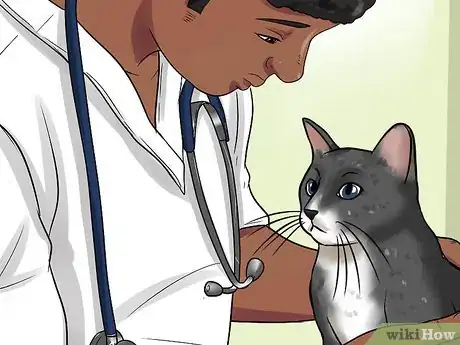



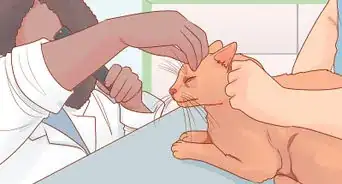

-Step-19.webp)














